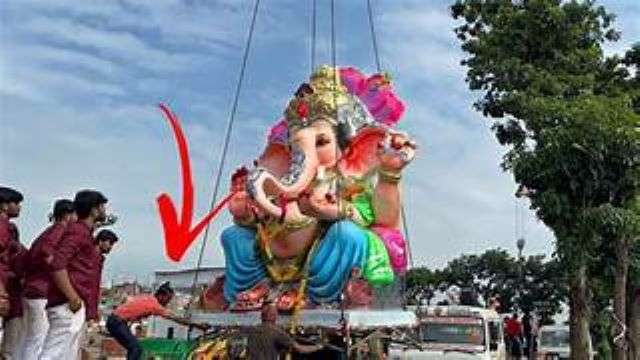Hyderabad/Mumbai: The cities of Hyderabad and Mumbai recently witnessed the culmination of the Ganesh Chaturthi festivities with massive idol immersion ceremonies. Both cities, renowned for their vibrant celebrations, ensured smooth and safe immersion processes through meticulous planning and coordination by local authorities. Here’s a detailed report on the scale, logistics, and safety measures implemented during the immersion process.
Record-Breaking Idol Immersions in Hyderabad: Hyderabad set a new record this year by immersing over 100,000 Ganesh idols across Greater Hyderabad. According to police reports, the final immersion of the iconic Khairatabad Ganesh, one of the largest idols in the city, was completed before noon on the final day. However, logistical slowdowns throughout the day led to a significant backlog of nearly 20,000 idols still awaiting immersion by the evening. Authorities estimated the immersion process to extend until 7 am the following morning.
Over the course of the 10-day festival, approximately 100,000 idols were immersed, with an additional 10,000 to 15,000 idols still in line for immersion late Tuesday evening. Despite the scale of the event, the city’s police and municipal authorities worked in harmony to ensure smooth operations and minimal disruptions.
Coordinated Efforts by Greater Hyderabad Police and Municipal Authorities: The Hyderabad police force deployed an impressive 25,000 officers to manage the final day of immersions. This comprehensive deployment included officers from traffic, law and order, and specialized units. Municipal workers, crane operators, and other support staff also worked tirelessly in shifts to maintain a steady flow of processions.
Authorities highlighted that this year’s immersion followed a scheduled plan, reducing delays compared to previous years. Extensive coordination meetings with mandapa (pandal) management teams helped streamline the immersion process. A detailed traffic plan was executed to minimize congestion and ensure safe movement of vehicles throughout the city.

Vibrant Celebrations Amid Orderly Processions: While the logistics were challenging, the cultural and spiritual fervor of the Ganesh Chaturthi celebrations remained undiminished. Processions by several Ganapati Mandals, community groups that organize the festivities, were filled with vibrant displays of devotion, frenzied dancing, and the traditional throwing of red “gulal” powder. Drum beats and “dhol-tasha” performances resonated throughout the city as devotees made their way to various lakes and artificial immersion ponds.
The city’s residents and devotees were actively involved in the process, and despite the scale of the event, no major untoward incidents were reported, further demonstrating the success of the safety measures put in place.
In Mumbai, where Ganesh Chaturthi is celebrated with unparalleled enthusiasm, more than 20,000 Ganesh idols were immersed on the final day of the festival. According to the Brihanmumbai Municipal Corporation (BMC), a total of 19,176 idols had been immersed by 6 pm. These included 17,996 household Ganesh idols, 1,053 Sarvajanik (public) idols, and 127 idols of Goddess Gauri. Approximately 7,570 idols were immersed in artificial ponds, a key initiative to reduce the environmental impact on natural water bodies.
The famous Lalbaugcha Raja procession, which draws lakhs of devotees every year, had reached Khatav Mill in Byculla by 11 pm, en route to Girgaon Chowpatty for its immersion. The final immersion was expected to take place the following morning.
Safety and Security Measures in Mumbai: Mumbai’s authorities also ensured that the immersion process ran smoothly, deploying over 24,000 police personnel across the city. Security forces included the State Reserve Police Force, Quick Response Teams, Riot Control Police, Home Guards, and the Maharashtra Security Force. The deployment of drones for aerial surveillance at key immersion points like Girgaon, Dadar, Juhu, and other prominent beaches further enhanced the security apparatus.
The BMC’s role in the immersion process was equally significant. Over 12,000 employees were stationed across the city, managing 204 artificial ponds, 71 control rooms, and 761 lifeguards. In addition, 48 speed boats were deployed at beaches to ensure public safety. Special precautions were issued, warning citizens of the presence of blue button jellyfish and stingrays in the water.
Mumbai’s transportation system also rose to the occasion. Both Western Railway and Central Railway ran special late-night trains to accommodate devotees returning home after participating in the processions. Traffic police personnel, numbering over 2,500, worked tirelessly to ensure smooth vehicular movement across the city, closing certain roads and rerouting traffic as necessary.
Dignitaries and Public Participation: In a show of solidarity with the devotees, key political figures in Maharashtra, including Governor C.P. Radhakrishnan, Chief Minister Eknath Shinde, and Deputy Chief Minister Devendra Fadnavis, participated in the celebrations. They were seen showering flowers on the Ganapati processions at Girgaon Chowpatty, a key immersion site.
Chief Minister Shinde also took the opportunity to highlight his government’s Ladki Bahin scheme, under which eligible women are provided with a monthly allowance of Rs 1,500. He emphasized that the joy of women during this festival had doubled, thanks to this welfare initiative.
The 2024 Ganesh Chaturthi immersions in both Hyderabad and Mumbai were a resounding success, with authorities in both cities demonstrating excellent coordination and planning. While the scale of the events was massive, safety, security, and environmental consciousness were prioritized, ensuring a smooth conclusion to one of India’s most beloved festivals. As the cities return to their regular rhythms, the memories of the celebrations will linger, reinforcing the cultural and spiritual significance of Ganesh Chaturthi in the hearts of millions.






